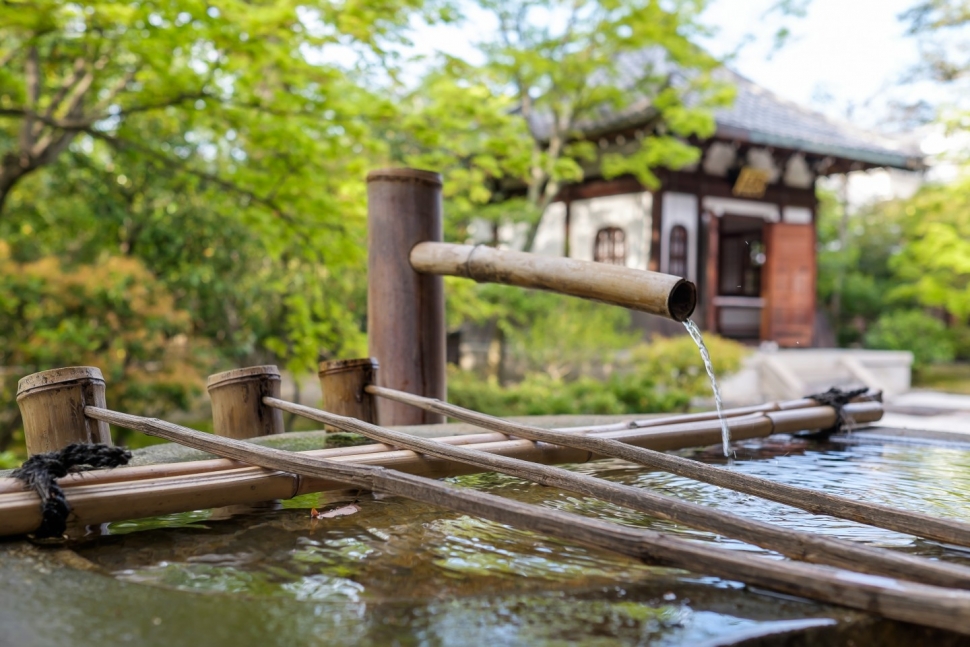Japanese gardens inspire a sense of serenity and symbolism

Our visit to Kyoto was during the beautiful sakura season in April so we could soak in the hanami (flower viewing) atmosphere, which is a tradition with the locals during this time of year.
The city is bustling with tourists and locals alike, socialising outdoors in the balmy springtime temperature. The bamboo groves are fortunately always open, and we are determined to enjoy the place in peace, so we arrive early at 7 a.m.
Taking advantage of our Japan Rail Pass, we jump on the train from Kyoto station to Saga Arashiyama station and follow the white signs on the pavement leading us to the site of the bamboo groves and Tenryū-ji Temple (Heavenly Dragon Temple). There are fewer than a handful of other visitors, all nodding with acknowledgement that the early wake-up call was well worth it.

The morning breeze makes the foliage of the bamboo rustle, and a stronger wind makes the bamboo shoots collide and chime with hollow chords. When we arrive at the beginning of the path, the sight is pure green serenity. The sunlight moves through the elegant shoots, carving different patterns on the path and reminding us of the limited time we have to enjoy this tranquillity.
After taking some photos and feeling like we’ve just finished a meditation class, we head out toward the entrance to a snack bar for a cup of hot soy milk with a red bean bun for breakfast.
Reenergised and warmed up, we stroll back and visit Tenryū-ji Temple, a World Heritage site since 1994. Shinto shrines and Buddhist temples are often located next to bamboo groves for strength and to ward off evil spirits. Tenryū-ji Temple is no different. Established in 1339 in memory of Emperor Go-Daigo, the temple is set on a small hill and hosts one of the oldest landscape gardens in Japan.

It boasts hundreds of different plants, though the cherry blossoms are the stars of the show. After paying our entrance fee of ¥500 (USD4.60/RM18), I look down at the carpet of colour. It is calm but full of life. There are different shades of pink and red contrasting perfectly with the rich greens. Huge peonies are bursting out for attention, and the Wada’s azaleas are just as striking, blending into the splendour with colourful precision.
We reach the bottom of the hill to a large pond with enormous koi carps and a beautiful landscape garden. Known as the Sōgenchi garden, it has retained the same form since the 14th century. Designed by the famous garden designer Muso Soseki, it perfectly fuses three key elements; white sand arranged in a pattern of gentle waves, representing Japanese waters; rocks and stones arranged around the pond, representing the coastline of China; and the views of Mount Arashiyama and Mount Kameyama in the background.

The next afternoon, after exploring Gion, Kyoto’s entertainment district, we head to Kennin-ji Temple in the same area. Whilst navigating the maze of tatami mat rooms and old Japanese artwork, the humming background noise from other visitors suddenly stops at a small zen garden. Positioned in front of the priests’ living quarters sits the Circle, Triangle and Square Garden based on calligraphic work by Sengai Gibon, a former temple abbot. It is adopted in the most minimalist form with the tree of life at the centre, a set of bamboos lying on a square rock, and a triangle form from the back wall when you are viewing the garden from a sitting position. The concept is that all things in this universe are represented by these three forms.
At the back of the temple is a larger garden, where we lull away the rest of the afternoon. In the corner, a five-tier stupa and a beautifully carved doorway add to the grandeur. The early evening sun casts long shadows from the bordering trees to take centre stage in the carefully raked gravel. The reduced colours and modest vegetation of the gardens are designed to aid in meditation about the meaning of life.

I can’t help but reflect and feel emotionally weightless. The crowds thin out at around 4.30 p.m., leaving me comfortably gazing out. We are the last to leave the temple, reluctantly putting our shoes back on before enjoying the nightly drama of Kyoto’s nightlife.
Good To Know:
- The first manual of Japanese gardens is called the Sakuteiki (Records of Garden Keeping), written at the end of the 11th century.
- Gravel is usually used in zen gardens, rather than sand, because it is less disturbed by rain and wind.
- Legend has it that evil spirits can only travel in a straight line, so a zigzag bridge in a Japanese garden traps the spirits, allowing one to escape to safety.
- The Japan Rail Pass has limited use in Kyoto as there are only a few JR lines on Kyoto’s transport system. The Arashiyama Bamboo Groves is one destination for which visitors can use it.
- The bamboo groves are free to enter and always open, so head there early to avoid the crowds.
- Tenryū-ji Temple is at the same site as the bamboo groves. Tenryū-ji Temple opens at 8.30 am until 5.30 pm. Entry fee is ¥500 for adults (USD4.60/RM18) and ¥300 (USD2.70/RM11) for children.
- Kennin-ji Temple, the oldest temple in Kyoto, opens at 10 am until 5 pm (last entry at 4.30 pm) near Gion. Entry fee is ¥500 for adults and ¥300 for children.
- The main room of Kennin-ji Temple, the Hatto, has a painting of two dragons on the ceiling measuring 11.4m by 15.7m. It commemorates the 800th anniversary of Kennin-ji’s founding and took two years to complete.
Main picture by Getty Images.





